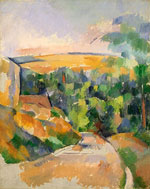
This exhibition is no longer on view at the National Gallery. Please follow the links below for related online resources or visit our current exhibitions schedule.
 Cézanne in Provence is the
principal international exhibition marking 2006 as the centenary
of the death of Paul Cézanne (1839–1906).
A key figure in the impressionist and post impressionist movements,
he is often seen as the father of modern art. This exhibition,
by focusing on the works Cézanne painted in and around
his native Aix-en-Provence, celebrates the landscape and
the rich associations it had for him.
Cézanne in Provence is the
principal international exhibition marking 2006 as the centenary
of the death of Paul Cézanne (1839–1906).
A key figure in the impressionist and post impressionist movements,
he is often seen as the father of modern art. This exhibition,
by focusing on the works Cézanne painted in and around
his native Aix-en-Provence, celebrates the landscape and
the rich associations it had for him.
Approximately 117 of Cézanne's greatest oil paintings and watercolors will demonstrate his intense emotional engagement with the countryside of his birthplace, where he painted some of his most compelling landscapes, penetrating portraits of family members, and the monumental series of Bathers from the National Gallery, London. Works depicting such scenes as Cézanne's family home of Jas de Bouffan, Montagne Sainte-Victoire, the Mediterranean coast at L'Estaque, the dramatic quarry at Bibémus, and the Château Noir will come from public and private collections throughout Europe and the United States.
Organization: Organized by the National Gallery of Art, Washington, the Musée Granet and the Communauté du Pays d'Aix, Aix-en-Provence, and the Réunion des muées nationaux, Paris.
Sponsor: This exhibition is made possible by a generous grant from the DaimlerChrysler Corporation Fund.
The exhibition is supported by an indemnity from the Federal Council on the Arts and the Humanities.
A Scholar in Cézanne's Provence:
The John Rewald Collections at the National Gallery of Art
Selected Highlights
(Download Flash player)
It seems fitting that John Rewald first discovered Paul Cézanne while crisscrossing Provence in the summer of 1933. Mirroring the painter's lifelong engagement with his home landscape, Rewald was to make Cézanne's depictions of the pays d'Aix and its inhabitants the primary focus of his scholarly life. Rewald was introduced to Cézanne's art through a chance meeting with Léo Marchutz (1903–1976), a young German artist then living in Aix, and the two set about photographing the various "sites Cézanniens" in the surrounding countryside. This systematic undertaking—a photographic repertory of the sites Cézanne depicted—can be seen as the distant seed of the catalogue raisonné of Cézanne's paintings that crowned Rewald's career.
There is no doubt that the same impulse to document comprehensively—to fix for posterity—led Rewald to choose the National Gallery of Art as the repository for his photographs, documentation, and personal library. Rewald thus enshrined his legacy at the same time he ensured that his scholarly materials would forever remain the basis for the continuing study of "his" beloved artist. The current exhibition in the Gallery's Library, organized in conjunction with Cézanne in Provence, includes items that document John Rewald's passionate interest in Cézanne. Rewald's annotated dissertation, early publications, site photographs, and object files are on display, along with a small selection of rare books on Cézanne collected by Rewald. Unquestionably, the department of image collections' holdings of site photographs, the Gallery Archives' complement of Rewald's scholarly files, the more than 10,000 personal books held in the National Gallery Library, and the exceptional collection of Cézanne's paintings and graphic works make the National Gallery one of the premiere destinations for the study of Cézanne.

